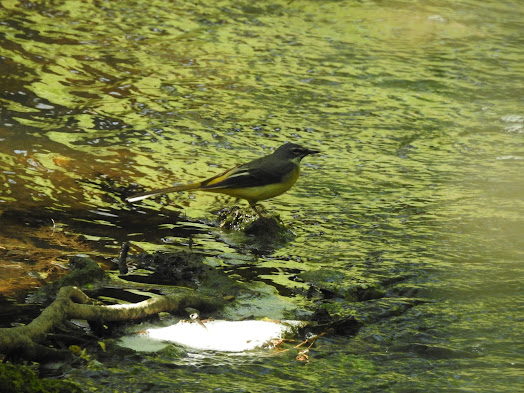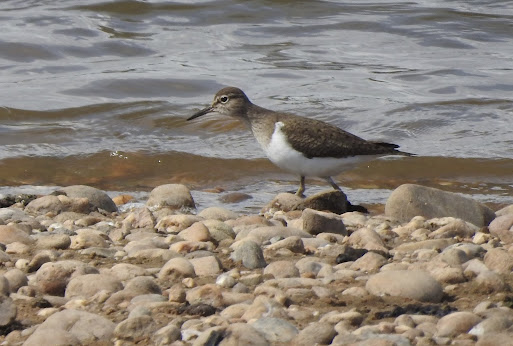Shortly after completing my last post, the Whatsapp pinged with news of eight Arctic Terns at Earlswood. They'd been reported on the Warwickshire Whatsapp Group (of which I am not a member) but then reposted on Earlswood Whatsapp by Matt.
I decided to go to see them and arrived 15 minutes later to the sight of a flock of terns wheeling about over Engine Pool. However, I couldn't pick out any Arctics among them. I carried on towards the causeway and discovered a group of terns sitting on the shingle island. I quickly decided they were Common Terns, and shortly afterwards Mick D-L appeared and said he now thought they were a mixture. He pointed out a particular tern among the flock as an Arctic. I photographed the flock and noticed that the bird in question seemed to have a dark red bill with an extensive black tip, so I jumped to the conclusion that it was a Common.
Then I noticed a single Arctic Tern flying around, and we all agreed that that at least was an Arctic. I tried to get some flight shots of it, with limited success. The main flock then took off and the job became even harder, particularly as I kept thinking I was on the Arctic, only to find it was dark-billed. What was going on?
 |
| Sorry about the poor quality, but this is my best shot of the undisputed Arctic |
On later reviewing my shots at home I changed my mind about the dark-billed tern. It's legs were noticeably short which surely made it an Arctic Tern notwithstanding the anomalous bill colour. This supports Mick's initial impression.
While it was flying around, although I was still calling it a Common Tern, I tried to get some shots of it. My best effort, such as it is, I think supports the re-identification as an Arctic Tern.
As a relief from all this tern stuff I located a Yellow Wagtail on the shingle island, and eventually managed to photograph that. Also another year-tick appeared, a first-summer Common Gull.
 |
| Common Gull |
Also present were at least three White Wagtails as well as numerous Pied Wags, at least two Common Sandpipers, and three Little Ringed Plovers.As a postscript I should add that Matt Griffiths arrived after I had left and confirmed at least one Arctic Tern was present, but was also happy, based on field views, that the nine others he saw were all Commons. I understand that all but two Commons then left to the north-east.
PPS: The case for the prosecution:
I've been mulling over this dark-billed "Arctic" Tern for some days, and have been reading everything I could get my hands on hoping for something that will support my re-identification of the tern as an Arctic. And I haven't really come up with anything.
It is generally agreed that occasionally Common Terns can appear in Spring in summer plumage with a largely dark bill, but the nearest reference I can find which says Arctic Terns can also do that comes from BWP (Birds of the Western Palearctic) which says that very rarely Arctic Terns can retain their dark winter bill in summer. It suggests this occurs where birds are in poor physical condition. It doesn't say what the rest of the bird looks like, and my guess would be that it refers to birds which retain winter plumage in summer.
I've also had another look at my photographs, and in particular one which I considered to contain eight Common Terns. I had assumed the "Arctic" was out of shot or had flown off, but on looking more closely I think I can see it, and it no longer looks short-legged.
 |
| Second from left, looking straight at me |
If this is the bird, it's a bit of a nail in the coffin of my re-identification. I also have to admit that my photo of the flying bird isn't very good. There is an obvious problem with photographing one bird from a flock of terns. You spot the bird with the bins, and then have to find it in the camera and shoot. It's all too easy to get the wrong bird. My photograph is not very sharp and maybe over-exposed. It could thus give a false impression, or even be of the actual Arctic Tern which was definitely present at the time.
Tony P, who was shooting at the flock from the other side of the lake, managed a much better photograph of what appears to be the dark-billed Tern. Assuming he has photographed the right bird, it also looks more like a Common than an Arctic as is shows more greyness on the upper wing than my shot does. It may also show the moult contrast between the inner and outer primaries which is the best way of separating Commons from Arctics. I will post Tony's photo if I get his permission to use it.
The upshot of all this mulling is that I think maybe there really were eight Common Terns and only one Arctic Tern present. Photography can be very useful, but it can also mislead. I tend to use my camera as a replacement scope, it has the advantage that you have a permanent record and its less hard on my ageing back, but maybe it pays to go with your birding instincts and not over-rely on it.
I'd like to say a lesson learnt....but I've said that before.



















































